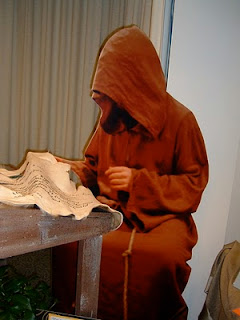One of my ancestors, Nancy Little McCoskey, was born in Downpatrick, County Down, Northern Ireland, so of course I became interested in learning more about Downpatrick.
From P.W. Joyce's
Irish Place Names:
Downpatrick takes its name from the large entrenched dun near the cathedral. [My note: Dun, or Down, means fortress.] In the first century this fortress was the residence of a warrior of the Red Branch Knights, called Celtchair, or Keltar of the battles, from whom it is called in Irish authorities, Dunkeltar. By ecclesiastical writers it is commonly called Dun-da-leth-glas, the fortress of the two broken locks (glas) or fetters. This long name was afterwards shortened to Dun or Down, which was extended to the county. The name of St. Patrick was added, to commemorate his connexion with the place.
Downpatrick is one of the oldest towns in Ireland. It was noted on Ptolemy's map in the 2nd century, although it wasn't what we think of as a town until the 18th century, and that's when my ancestor was born there.
The following came from this web site:
http://freepages.genealogy.rootsweb.ancestry.com/~rosdavies/PHOTOSwords/DownAll.htm In 1703 Edward Southwell, Chief Secretary of Ireland, married Elizabeth, daughter of the Earl of Ardglass, thus acquiring the Manor of Down. He decided to develop its economic potential; he controlled the waters of the Quoile river and reclaimed the marshes, built a harbour and customs house and reconstructed the streets of the town. His son, who succeeded him in 1730, continued his work and through their efforts, Downpatrick changed from a derelict town of less than 1,000 inhabitants into a prosperous commercial centre for the barony. The first Court House was built in 1737 at a cost of £3000.
The Littles were tenant farmers, so I expect Downpatrick was given as Nancy Little's birthplace because it was the closest recognizable location. I imagine she was born on a farm.

This church is in Ballee. It's Presbyterian and was built in 1721, 50 years before the Littles immigrated. It's possible they attended here or at a similar church.
Downpatrick is a beautiful place, which I plan to visit soon. I'm sure I'll contemplate Nancy Little while I'm there. She was quite a woman. She came to America with her parents and four siblings, leaving her older sister Mary behind who was indentured until she could pay for the passage. Later Nancy married John McCoskey and traveled through the Cumberland Gap with her parents, her husband, and her children to the wild lands of Kentucky. Her parents and her husband died in Kentucky and Nancy moved again, bringing her hoard of children to the wilderness of Indiana where her younger brother lived and where she and John had purchased land. She was apparently a shrewd business woman, but other than what I can assume about her character from her actions, I know nothing about her. In her old age she relocated once again, this time to the wild west (Texas) with one of her daughters.
Downpatrick is not "where it all began." That's a phrase my husband and noted a lot while watching the television series,
Who Do You Think You Are? The people who were searching for their roots on that show always seemed to find a place in a foreign land and say, "This is where it all began!" Nancy's father was born in Scotland and if I could keep tracing generations back, I'd end up with Adam and Eve, wouldn't I? But still, finding a place where one of your ancestors was born always makes you feel like you've come home--it's a type of connection to the past that grounds you in the present. Know what I mean?














